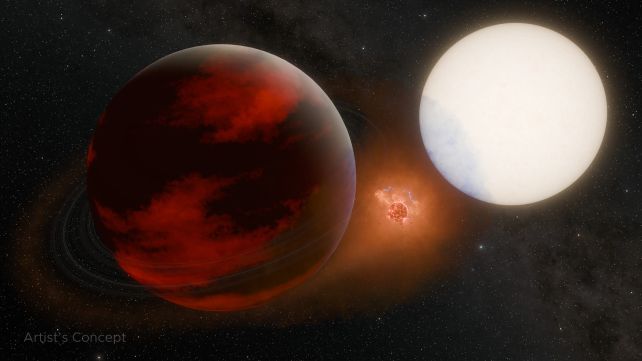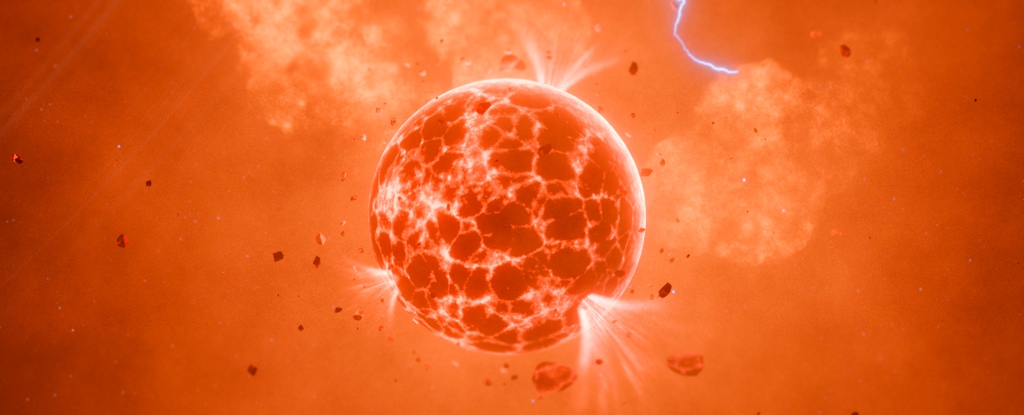Products You May Like
Around a neighboring star just 635 light-years away, astronomers have found even more evidence of a moon absolutely livid with volcanoes.
There is a giant cloud of sodium consistent with volcanic activity, orbiting an exoplanet named WASP-49b, orbiting in turn a yellow dwarf star named WASP-49.
And how do we know that the sodium is from an exomoon? The exoplanet is a gas giant, unlikely to host volcanoes – and the sodium cloud is out of sync with the exoplanet’s orbit, but exactly what we might expect if WASP-49b had a rocky volcanic moon.
“We think this is a really critical piece of evidence,” says astrophysicist Apurva Oza of the California Institute of Technology. “The cloud is moving in the opposite direction that physics tells us it should be going if it were part of the planet’s atmosphere.”
Moons ought to be scattered throughout the Milky Way galaxy in a glorious profusion. Here in the Solar System, moons dramatically outnumber the planets they orbit: they number nearly 300 known at time of writing, compared to just eight planets.

We’ve found very little evidence of these extrasolar moons, however. Finding exoplanets is hard enough – evidence of exomoons is so tiny that we haven’t been able to detect it, or, if we have, there are better explanations for it.
As with many detections in space, the thing we find first is likely to be an extreme outlier, one whose signal is large and strange enough to be detected, and to only fit a narrow range of explanations.
This seems to be the case with WASP-49b. Back in 2017, a paper on the exoplanet’s atmosphere revealed the presence of a layer of sodium enshrouding the gas giant, at unusual altitudes much higher than its clouds.
In 2019, Oza and his colleagues published a paper laying out their argument that the sodium was generated, not by the exoplanet, but by an orbiting exomoon, similar to, but much more volcanic than Jupiter‘s moon Io.
We’ve found volcanic exoplanets before. They tend to be rocky worlds with characteristics that indicate volcanism, such as pronounced orbital eccentricity, temperature profiles, or atmospheric properties.
Gas giants don’t have volcanoes, since they are terrestrial by nature, but there did remain a possibility that the sodium signature observed on WASP-49b was the product of planetary activity, such as a planetary wind. Oza and his colleagues have been collecting data to confirm their earlier finding that the gas cloud was likely exolunar in origin.
They used the European Southern Observatory’s Very Large Telescope to observe the star and its exoplanet for four nights.
We already knew that the exoplanet clocks in at 0.37 times the mass and 1.1 times the radius of Jupiter, orbiting its Sun-like star once every 2.8 days. When the researchers took a long, hard look at the system, they found that the sodium cloud is not constantly present, but comes and goes, disappearing behind the exoplanet and star at irregular intervals.
frameborder=”0″ allow=”accelerometer; autoplay; clipboard-write; encrypted-media; gyroscope; picture-in-picture; web-share” referrerpolicy=”strict-origin-when-cross-origin” allowfullscreen>
Neutral sodium photoionizes within minutes, which means that it can’t last long in the vicinity of a star without gaining a charge. Since the sodium the team detected is neutral, that means its production must be constant and ongoing.
One possible explanation was production within the exoplanet; but the intervals at which the sodium cloud appeared were out of sync with WASP-49b’s rotation, meaning it could not be linked to a location within the exoplanet.
Oza and his colleagues used computer modeling, and determined that the observed signal is most consistent with a volcanic exomoon orbiting WASP-49b once every eight hours or so.
Thanks to the relationship between Jupiter and Io, we have a good handle on how and why this exomoon is so volcanic. It’s likely being pushed and pulled by gravitational tugging as it orbits WASP-49b, perhaps even by other moons, as Io is tugged by the other Galilean moons of Jupiter.
It’s also extremely close to its planetary companion, which means that, added to its mass loss due to volcanism, its orbit is likely to decay on relatively short timescales, resulting in an eventual fall into WASP-49b.
“If there really is a moon there, it will have a very destructive ending,” Oza says.
The findings have been published in The Astrophysical Journal Letters.
